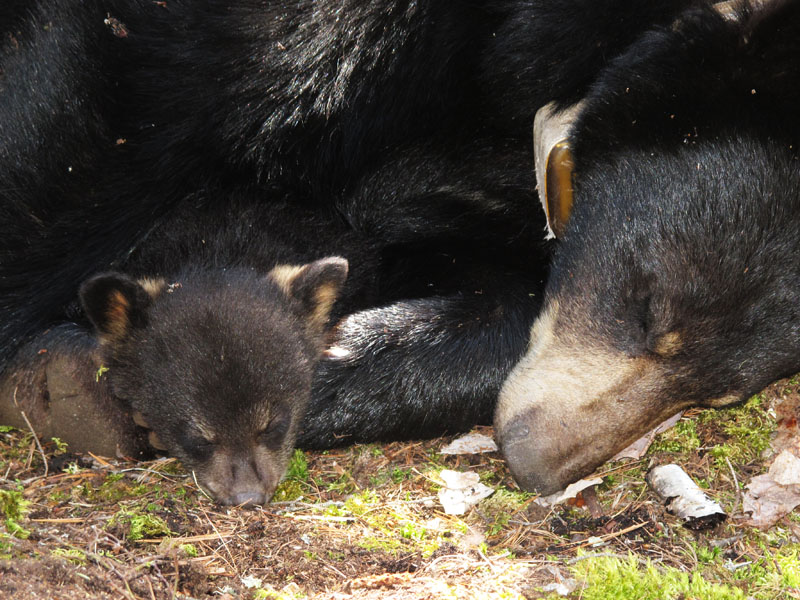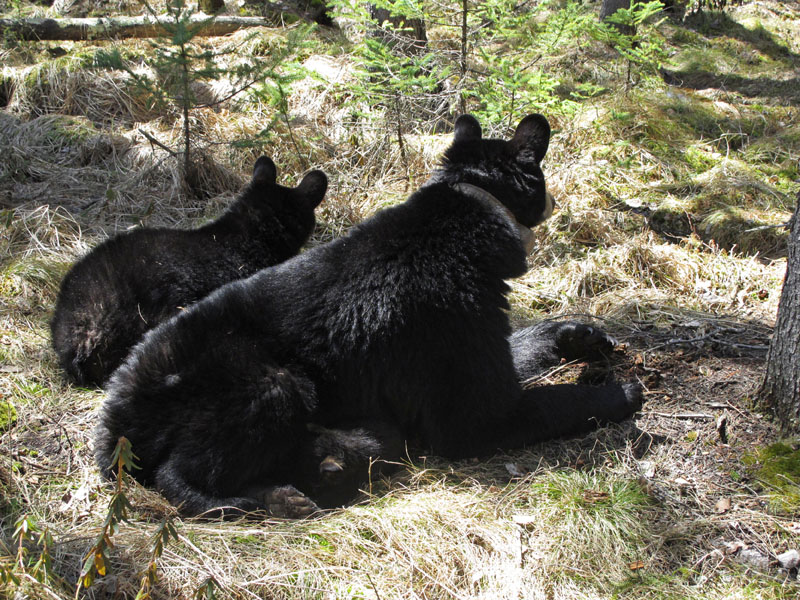No better, no worse
 In our check of Lily today, she was about the same. She had no interest in food, wanted to be left alone, and moved away when we tried to approach. When we first saw them, Hope was up a tree being her energetic self. Lily and Faith were lying at the base of a red pine that June, Lily, and Hope have used in years past. Although Lily moved off as we approached today, a call from Faith brought Lily back to her. Lily then moved away again with Faith toddling after, which is when we left.
In our check of Lily today, she was about the same. She had no interest in food, wanted to be left alone, and moved away when we tried to approach. When we first saw them, Hope was up a tree being her energetic self. Lily and Faith were lying at the base of a red pine that June, Lily, and Hope have used in years past. Although Lily moved off as we approached today, a call from Faith brought Lily back to her. Lily then moved away again with Faith toddling after, which is when we left.
We are working with an experienced veterinarian and with one of the top rehabbers in the country. In brainstorming, here are possibilities that came up.
- Giardia. The rehabber has found this protozoan infection of the small intestine in a cub but never an adult. The symptoms of diarrhea and loss of appetite are what Lily is showing, but most people who get giardiasis develop an immunity to it. Perhaps bears do, too, which could explain why it was found in a cub and never in an adult bear. The veterinarian will microscopically examine Lily’s stool (collected yesterday) for this in the morning.
- Coccidia. This protozoan infection of the intestine has been reported in bears. It causes diarrhea and loss of appetite like Lily shows, but Lily’s stool sample does not show a third typical symptom—bloody stool. The veterinarian may check for coccidia anyway.
- Aflatoxin. These mycotoxins cause liver disease in dogs, humans, and other animals, but we know of no report of it in a bear.
- Ketosis. Symptoms of this chemical imbalance include fatigue and lack of appetite, which Lily shows, and it can occur with excessive weight loss as may be the case with Lily. However, a symptom is excessive thirst, which Lily has not demonstrated. She didn’t drink at all during the five and a half hours of observation yesterday. A symptom of this is fruity acetone breath, which we wanted to sniff for today, but Lily wouldn’t let us come close.
- Intestinal obstruction. Always a possibility for any species but not common in bears. We know of no report of it. Diarrhea can occur, but constipation, vomiting, bloating, and abdominal distension are more likely, and she shows none of those symptoms.
- Poison. There was hair in her stool, which probably means Lily ate a carcass. First guess—a coyote. Not everyone likes coyotes. Could it have been poisoned? If that were the case, we would expect Hope to show symptoms as well and Hope seems fine.
 More observations from yesterday. Lily had Faith snuggled close to her much of the time, drawing her in to rest and nurse at will. We wonder how much milk she is producing, though. She has little fat left. It’s time for green-up so she can make milk from food instead of fat and other body stores. A few things are starting to poke out of the ground but are mostly still under the litter. Hope could smell them and uncovered them to forage. She roamed out from Lily and disappeared several times. When she came back by Lily, she wanted to play but Lily was too lethargic to participate. Hope played vigorously with Faith a while and then headed off again. Faith followed. With Hope and Faith both moving off, Lily followed. They settled where Hope had been foraging.
More observations from yesterday. Lily had Faith snuggled close to her much of the time, drawing her in to rest and nurse at will. We wonder how much milk she is producing, though. She has little fat left. It’s time for green-up so she can make milk from food instead of fat and other body stores. A few things are starting to poke out of the ground but are mostly still under the litter. Hope could smell them and uncovered them to forage. She roamed out from Lily and disappeared several times. When she came back by Lily, she wanted to play but Lily was too lethargic to participate. Hope played vigorously with Faith a while and then headed off again. Faith followed. With Hope and Faith both moving off, Lily followed. They settled where Hope had been foraging.
 Sick adult bears are seldom seen, maybe because they don’t move around enough to be seen. We remember a yearling that was bloated and seemed to be writhing in pain, but that lasted maybe a day. Of course, 26 ¾ year old Midge died of blastomycosis in November 2009, and back in the early 1970’s a 21-year-old mother with 2-month-old cubs died at her den in March. Researchers using traditional study methods don’t get many views of bears and therefore aren’t apt to see when a bear is sick if the bear recovers and moves on. Also, few adult bears die from non-human-related causes. Based on that, we suspect that Lily will recover, but we worry she might lose Faith in the process. It may be that a cause of death of cubs is temporary sickness in mothers.
Sick adult bears are seldom seen, maybe because they don’t move around enough to be seen. We remember a yearling that was bloated and seemed to be writhing in pain, but that lasted maybe a day. Of course, 26 ¾ year old Midge died of blastomycosis in November 2009, and back in the early 1970’s a 21-year-old mother with 2-month-old cubs died at her den in March. Researchers using traditional study methods don’t get many views of bears and therefore aren’t apt to see when a bear is sick if the bear recovers and moves on. Also, few adult bears die from non-human-related causes. Based on that, we suspect that Lily will recover, but we worry she might lose Faith in the process. It may be that a cause of death of cubs is temporary sickness in mothers.
We are crossing our fingers that they all make it and are doing our best to learn what made Lily sick. The veterinarian is coming tomorrow morning to work on the stool sample with us. At this moment, we noticed that Lily moved over a quarter mile. That’s farthest she has moved in 5 days. Does this mean she is getting better? We’ll visit her again tomorrow to look for signs of improvement.
 Today, we gave Juliet a new radio-collar with a GPS unit and gave her sweet yearling Shirley a small radio-collar without a GPS unit. Jo and cub are still in the 230-yard diameter area they have used since April 15.
Today, we gave Juliet a new radio-collar with a GPS unit and gave her sweet yearling Shirley a small radio-collar without a GPS unit. Jo and cub are still in the 230-yard diameter area they have used since April 15.
The temperature stayed warm (high 40’s) overnight last night and the ice disappeared from all the lakes in the study area. Snow is down to patches in sheltered ravines and hillsides and, of course, the piles from snowplows.
A thank you again to Carol Decker, Patrick McKibbage, and Team Bear for the drawing to win the number 1 of 350 signed and numbered prints of Lily and Hope at their den a year ago. The drawing is at 11 AM Eastern Time tomorrow (Sunday). The link to the drawing is http://www.facebook.com/topic.php?uid=263755115498&topic=20607 . Thank you for the generous participation we are seeing.
In the Readers Digest contest to win money for Ely, we are in 6th place and holding firm. The link to vote 10 times in a row each day through May 16 is http://wehearyouamerica.readersdigest.com/town.jsp?town=ELY&state=MN.
In the Chase contest to win money for the International Wolf Center, we are comfortably holding on to 3rd place thanks to your efforts to find more and more new voters. This is the contest where we can vote only once through May 4. To vote, go to this link http://www.facebook.com/ChaseCommunityGiving and click “Like.” Then go to this link http://apps.facebook.com/chasecommunitygiving/charities/411543539-international and register your vote for the International Wolf Center.
Dana Coleman’s first grade class initiated a petition to have the American black bear named Minnesota’s state mammal and it is catching on among students of all ages. We would love to have this happen as a result of a grassroots effort started by students. The link to the class’s petition is http://www.thepetitionsite.com/1/BlackBear-MNState-Mammal/.
Thank you for all you are doing.
—Lynn Rogers and Sue Mansfield, Biologists, Wildlife Research Institute and North American Bear Center
